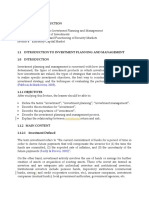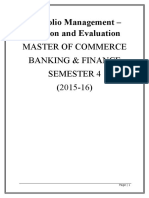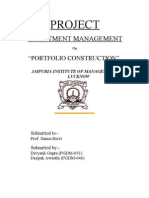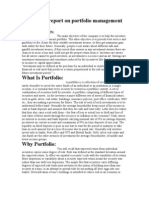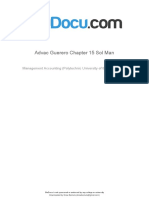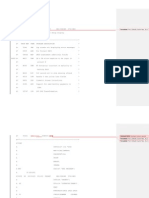0 ratings0% found this document useful (0 votes)
7 viewsBasics of Investment (Part-II)
Basics of Investment (Part-II)
Uploaded by
Ariful Haidar MunnaThe document discusses the basics of portfolio management, including defining a portfolio as a grouping of financial and real assets held by investors. It outlines the key steps in portfolio management process as constructing a policy statement, examining current and projected economic conditions, implementing the portfolio plan, and providing continual feedback. The goal of portfolio management is to meet an investor's objectives as specified in the policy statement while minimizing risks based on changes in the market.
Copyright:
© All Rights Reserved
Available Formats
Download as PPTX, PDF, TXT or read online from Scribd
Basics of Investment (Part-II)
Basics of Investment (Part-II)
Uploaded by
Ariful Haidar Munna0 ratings0% found this document useful (0 votes)
7 views23 pagesThe document discusses the basics of portfolio management, including defining a portfolio as a grouping of financial and real assets held by investors. It outlines the key steps in portfolio management process as constructing a policy statement, examining current and projected economic conditions, implementing the portfolio plan, and providing continual feedback. The goal of portfolio management is to meet an investor's objectives as specified in the policy statement while minimizing risks based on changes in the market.
Copyright
© © All Rights Reserved
Available Formats
PPTX, PDF, TXT or read online from Scribd
Share this document
Did you find this document useful?
Is this content inappropriate?
The document discusses the basics of portfolio management, including defining a portfolio as a grouping of financial and real assets held by investors. It outlines the key steps in portfolio management process as constructing a policy statement, examining current and projected economic conditions, implementing the portfolio plan, and providing continual feedback. The goal of portfolio management is to meet an investor's objectives as specified in the policy statement while minimizing risks based on changes in the market.
Copyright:
© All Rights Reserved
Available Formats
Download as PPTX, PDF, TXT or read online from Scribd
Download as pptx, pdf, or txt
0 ratings0% found this document useful (0 votes)
7 views23 pagesBasics of Investment (Part-II)
Basics of Investment (Part-II)
Uploaded by
Ariful Haidar MunnaThe document discusses the basics of portfolio management, including defining a portfolio as a grouping of financial and real assets held by investors. It outlines the key steps in portfolio management process as constructing a policy statement, examining current and projected economic conditions, implementing the portfolio plan, and providing continual feedback. The goal of portfolio management is to meet an investor's objectives as specified in the policy statement while minimizing risks based on changes in the market.
Copyright:
© All Rights Reserved
Available Formats
Download as PPTX, PDF, TXT or read online from Scribd
Download as pptx, pdf, or txt
You are on page 1of 23
Basics of Investment
(Part-II)
Instructor:
Md. Thasinul Abedin
MBA(AIS,DU), BBA(AIS,DU)
Lecturer, Department of Accounting
Faculty of Business Administration
University of Chittagong
Portfolio?
A portfolio is a grouping of assets (Financial or Real or In
combination).
Portfolios are held directly by investors and/or managed by
financial professionals (For example, the fund managers).
Portfolio Management
Portfolio management refers to the professional management of
securities and other financial assets or real assets. Also referred to
as “asset management” and “wealth management”.
More specifically, Portfolio management includes a range of
professional services to manage an individual's and company's
securities, such as stocks and bonds, and other assets, such as real
estate.
Portfolio management is executed in accordance with a specific
investment goal and investment profile and takes into
consideration the level of risk, diversification, period of
investment or maturity etc.
Portfolio Management Process
The process of managing an investment portfolio never stops. Once the
funds are initially invested according to the plan, the real work begins in
evaluating the portfolio’s performance and updating the portfolio
based on changes in economic environment and the investor’s needs.
Steps in Portfolio Management Process
1. Construction of a Policy Statement.
2. Examine current and projected financial, economic, political,
and social conditions.
3. Implement the plan by constructing the portfolio.
4. Feedback Loop.
Construction of a Policy Statement
The first step in portfolio management process for the investor is
to construct a policy statement either alone or with the assistance
of the investment advisor.
The policy statement is a road map. In it, investors specify the
types of risk they are willing to take and their investment goals
and constraints.
All investment decisions are based on the policy statement to
ensure that these decisions are appropriate for the investor.
Construction of a Policy Statement (cont..)
Because the investor needs, goals, and constraints change over
time, the policy statement must be periodically reviewed and
updated.
It is an invaluable planning tool that will help the investor
understand his or her needs better as well as assist an advisor or
portfolio manager in managing client’s funds.
Though it does not guarantee investment success, a policy
statement will provide discipline for the investment process and
reduce the possibility of making hasty and inappropriate
decisions.
Construction of a Policy Statement (cont..)
• There are two important reasons for constructing a portfolio
policy statement:
First, it helps the investor decide on realistic investment
goals after learning about the financial markets and the risks of
investing.
Second, it creates a standard by which to judge the
performance of the portfolio manager.
Investment Objectives (Goals)
The investor’s objectives are his or her investment goals expressed in
terms of both risk and return.
The relationship between risk and return (+ve) requires that goals not
be expressed only in terms of return. Expressing goals only in terms of
returns can lead to inappropriate investment practices by the portfolio
manager such as the use of high-risk investment strategies or account
churning (agitating) which involves moving quickly in and out of
investments in an attempt to buy low and sell high.
Investment Objectives (Goals) (cont…)
For example, a person may have a stated return goal such as
“double my investment in five years”. Before such a statement
becomes part of the policy statement, the client must become
fully informed of investment risks associated with such a goal.
A careful analysis of the client’s risk tolerance should precede any
discussion of return objectives.
Investment firms survey clients to gauge their risk tolerance.
Sometimes investment magazines or books contain tests that
individuals can take to help them evaluate their risk tolerance.
Investment Objectives (Goals) (cont…)
Risk tolerance is more than a function of an individual’s
psychological make up. It is affected by other factors, including a
person’s current insurance coverage and cash reserves. Risk tolerance
is also affected by an individual’s family situation (for example,
marital status and the number and ages of children) and by his or her
age.
Investment Objectives (Goals) (cont…)
Even though a person’s return objective may be stated in terms of
absolute or relative return, it may also be stated in terms of
general goals such as capital preservation, current income, capital
appreciation, or total return.
a. Capital Preservation: Investors want to minimize their
risk of loss, usually in real terms: they seek to maintain the
purchasing power of their investment. In other words, the return
needs to be no less than the rate of inflation. Generally, this is a
strategy for strongly risk-averse investors or for funds needed
in short run, such as for next year tuition payment or down
payment of a house.
Investment Objectives (Goals) (cont…)
b. Capital Appreciation: It is an appropriate objective when
investors want the portfolio to grow in real terms over time to
meet some future needs. This is an aggressive strategy for
investors willing to take on risk to meet their objectives.
Generally longer term investors seeking to build a retirement or
college education fund may have this plan. Under this strategy
growth mainly occurs through capital gains.
c. Current Income: Investors mainly concentrate generating
income from the portfolio rather than capital gains. This
strategy generally suits investors who want to supplement their
earnings with the income generated by the portfolio to meet
their living expenses.
Investment Objectives (Goals) (cont…)
d. Total return: It is similar as capital appreciation
objective. However capital appreciation objective wants to grow
up capital through the capital gain, the total return wants the
capital grow up by capital gain and reinvesting current income.
Because the total return strategy has both income and capital
gain components, its risk exposure lies between risk of the
current income and capital appreciation strategies.
Investment Objectives (Goals) (cont…)
Investment Objective: 25 years old [ See: Reily and Brown]
Investment Objective: 65 years old [ See: Reily and Brown]
Investment Constraints
Liquidity Needs
Time Horizon
Tax Concern
Legal and Regulatory Requirements
Unique Needs and Preferences
Note: Investment Objectives and Constraints are the input to the policy
statement.
Evaluating Portfolio Performance
Select a benchmark portfolio.
The benchmark may be S&P 500 Index, DSEX, DSE30 etc.
For example, portfolio return is 10% where the S&P 500 return is
9%. The portfolio has beat or outperformed the market.
A few questions raised to construct a policy
statement
What are the real risks of an adverse financial outcome, especially in
the short run.
What probable emotional reactions will I have to an adverse financial
outcome?
How knowledgeable am I about investments and financial markets?
What other capital and income sources do I have?
How important is this particular portfolio to my overall financial
position?
What, if any , legal restrictions may affect my investment needs?
A few questions raised to construct a policy
statement (cont…)
How would any unanticipated fluctuations in my portfolio value affect
my investment policy?
Examine current and projected financial,
economic, political, and social conditions.
In the second step of the portfolio management process, the portfolio
manager studies current financial and economic conditions (interest rate,
inflation, exchange rate, and central bank policies etc.) and forecast
future trends.
The investor’s needs, as reflected in the policy statement, and financial
market expectations will jointly determine investment strategy.
Economies are dynamic. They are affected by numerous industry
policies, politics, and changing demographic and social attributes.
Examine current and projected financial,
economic, political, and social conditions (cont..)
Thus, the portfolio will require constant monitoring and updating to
reflect changes in financial market expectations.
Implement the plan by constructing the
portfolio
The third step is to construct the portfolio.
With the investor’s policy statement and financial market forecasts as
input, the advisors implement the investment strategy and determine
how to allocate available funds across different countries, asset
classes, and securities.
This involves constructing a portfolio that will minimize the investor’s
risk while meeting the needs specified in the policy statement.
Feedback Loop (Continual Monitoring)
The fourth step in the portfolio management process is the continual
monitoring of investor’s needs and capital market expectations and,
when necessary, updating the policy statement. Based upon all of this,
the investment strategy is modified accordingly.
An important component of the monitoring process is to evaluate a
portfolio’s performance and compare the relative results to the
expectations and the requirements listed in the policy statement.
You might also like
- Bill Hotel Dago BandungDocument2 pagesBill Hotel Dago BandungAngga Ciro Bams50% (2)
- Project Report On Portfolio ConstructionDocument37 pagesProject Report On Portfolio ConstructionMazhar Zaman75% (4)
- Alrajhi-0 1783979451123987Document1 pageAlrajhi-0 1783979451123987Shahad MansorNo ratings yet
- Indymac Federal Bank FSB, Plaintiff, vs. Israel A. Machado - 50 2008 CA 037322xxxx MBDocument29 pagesIndymac Federal Bank FSB, Plaintiff, vs. Israel A. Machado - 50 2008 CA 037322xxxx MBForeclosure Fraud100% (1)
- Chapter 7 - Portfolio inDocument12 pagesChapter 7 - Portfolio intemedebereNo ratings yet
- IPM ReviewerDocument8 pagesIPM ReviewerPaul Jancen ConcioNo ratings yet
- Content: Sr. No. Particulars NODocument21 pagesContent: Sr. No. Particulars NORANG2812No ratings yet
- Steps of Portfolio Management Process /steps of Portfolio ManagementDocument8 pagesSteps of Portfolio Management Process /steps of Portfolio ManagementRuchi KapoorNo ratings yet
- Topic 1 IPMDocument22 pagesTopic 1 IPMmeshack mbalaNo ratings yet
- Assignment Cover Sheet: Northrise UniversityDocument7 pagesAssignment Cover Sheet: Northrise UniversityPatrick ChibabulaNo ratings yet
- IPSDocument6 pagesIPSAjay KumarNo ratings yet
- Portfolio Evaluation and RevisionDocument32 pagesPortfolio Evaluation and RevisionHarshit Gandhi100% (1)
- Vanguard InvestingDocument40 pagesVanguard InvestingrasmussenmachineNo ratings yet
- Chapter 1 The Portifolio Management Process Chapte 1Document9 pagesChapter 1 The Portifolio Management Process Chapte 1Panashe MachekepfuNo ratings yet
- Master in Business Administration - Semester 3 MF0010 - Security Analysis and Portfolio Management - 4 Credits Assignment Set-1 (60 Marks)Document11 pagesMaster in Business Administration - Semester 3 MF0010 - Security Analysis and Portfolio Management - 4 Credits Assignment Set-1 (60 Marks)Sumit ChhuganiNo ratings yet
- Portfolio ASSIGNMENTDocument8 pagesPortfolio ASSIGNMENTuckabcedefNo ratings yet
- "Portfolio Management"-An Empirical Study On The Art of InvestingDocument59 pages"Portfolio Management"-An Empirical Study On The Art of Investingpriyanka singhalNo ratings yet
- Capital Market and Portfolio ManagementDocument10 pagesCapital Market and Portfolio ManagementFlora ChauhanNo ratings yet
- Unit 1 Financial Planning and Tax ManagementDocument18 pagesUnit 1 Financial Planning and Tax ManagementnoroNo ratings yet
- MBA Project TopicsDocument15 pagesMBA Project TopicsAvinash BilagiNo ratings yet
- Portfolio ManagementDocument86 pagesPortfolio ManagementSenelwa AnayaNo ratings yet
- Sapm 1Document21 pagesSapm 1Divya BhadriNo ratings yet
- Portfolio ManagmentDocument30 pagesPortfolio ManagmentMitali Amagdav100% (1)
- What Is Portfolio Management and Why Is It Good For Investment PlanningDocument12 pagesWhat Is Portfolio Management and Why Is It Good For Investment PlanningJeffrey RiveraNo ratings yet
- MF0010 Set1 Q1& 2Document5 pagesMF0010 Set1 Q1& 2s_konarNo ratings yet
- Portfolio Management and Perfomance EvaluationDocument14 pagesPortfolio Management and Perfomance EvaluationAnishahNo ratings yet
- Objectives & Scope of Portfolio ManagementDocument4 pagesObjectives & Scope of Portfolio ManagementGourav BaidNo ratings yet
- Institutional Investment Management NotesDocument13 pagesInstitutional Investment Management NotesFineman TlouNo ratings yet
- Understanding Investment ObjectivesDocument5 pagesUnderstanding Investment ObjectivesDas RandhirNo ratings yet
- Nvestment Nvironment: 1.1. Introduction To InvestmentDocument12 pagesNvestment Nvironment: 1.1. Introduction To InvestmentAzizul AviNo ratings yet
- Project: Investment ManagementDocument13 pagesProject: Investment ManagementdivvyankguptaNo ratings yet
- Portfolio ManagementDocument15 pagesPortfolio Managementnisha.shahi076No ratings yet
- Investment and Portfolio MGT CH 1 & 2Document27 pagesInvestment and Portfolio MGT CH 1 & 2seadazinab064No ratings yet
- Portfolio Management of Reliance SecuritiesDocument29 pagesPortfolio Management of Reliance SecuritiesVasavi DaramNo ratings yet
- Unit 4a Portfolio ManagementDocument22 pagesUnit 4a Portfolio ManagementKashish JainNo ratings yet
- Abhi FinalDocument9 pagesAbhi Finalanon_244519626No ratings yet
- Definition of Portfolio MGT Portfolio Is None Other Than Basket of Stocks. Portfolio Management Is The ProfessionalDocument9 pagesDefinition of Portfolio MGT Portfolio Is None Other Than Basket of Stocks. Portfolio Management Is The Professionalabhi_akNo ratings yet
- Vanguard Principles InvestingDocument40 pagesVanguard Principles InvestingRemo RaulisonNo ratings yet
- CapitalDocument4 pagesCapitalshikha singhNo ratings yet
- PORTFOLIO MANAGEMENTDocument33 pagesPORTFOLIO MANAGEMENTMohit AggarwalNo ratings yet
- Chapter - I: Introduction To FinanceDocument61 pagesChapter - I: Introduction To FinanceParisa ChanduNo ratings yet
- For A Rich Future: Owning A Car, A HouseDocument11 pagesFor A Rich Future: Owning A Car, A Housedbsmba2015No ratings yet
- Los: 40 Portfolio Management: An Overview: A Portfolio Perspective On InvestingDocument2 pagesLos: 40 Portfolio Management: An Overview: A Portfolio Perspective On InvestingArpit MaheshwariNo ratings yet
- Topic 2 Katkat Report...Document2 pagesTopic 2 Katkat Report...Maria Isabelle DamascoNo ratings yet
- Notes For First-Time Investors-CgDocument22 pagesNotes For First-Time Investors-Cgronysk90No ratings yet
- Project Report On Portfolio ManagementDocument6 pagesProject Report On Portfolio Managementanunazanu100% (1)
- B P P C: Asics OF Ortfolio Lanning AND OnstructionDocument6 pagesB P P C: Asics OF Ortfolio Lanning AND Onstructionhero66No ratings yet
- Class Report For Investment ManagementDocument5 pagesClass Report For Investment ManagementS VasanthNo ratings yet
- Unit 1 SAPMDocument18 pagesUnit 1 SAPMHansa rathoreNo ratings yet
- Investment Analysis and Portifolio Mgt-JIGDAN xDocument107 pagesInvestment Analysis and Portifolio Mgt-JIGDAN xyirgabogale16No ratings yet
- What Is Portfolio ManagementDocument14 pagesWhat Is Portfolio Managementnisha.shahi076No ratings yet
- Portfolio Management - India BullsDocument103 pagesPortfolio Management - India BullsNarsing Rao BodduNo ratings yet
- Why Is Investment Analysis ImportantDocument2 pagesWhy Is Investment Analysis Importantxxtha999No ratings yet
- Project On Portfolio ManagementDocument13 pagesProject On Portfolio Managementpayal22octNo ratings yet
- TextDocument14 pagesTextsundaram MishraNo ratings yet
- Port Folio ManagementDocument16 pagesPort Folio ManagementanjanigolchhaNo ratings yet
- Id 49 BMDocument13 pagesId 49 BMMd Majedul HaqueNo ratings yet
- Letter of Transmittal: Subject: Submission of Term PaperDocument17 pagesLetter of Transmittal: Subject: Submission of Term PaperRifat HelalNo ratings yet
- PART 5 - Risk and ReturnDocument4 pagesPART 5 - Risk and Returnsubire09No ratings yet
- Subject: - : Special Studies in FinanceDocument18 pagesSubject: - : Special Studies in Financeshahnikita96No ratings yet
- The Investors Mindset: Mastering the Wealth Code by Unveiling Untapped PotentialFrom EverandThe Investors Mindset: Mastering the Wealth Code by Unveiling Untapped PotentialNo ratings yet
- How to Create and Maintain a Diversified Investment Portfolio: A Comprehensive Guide on Investment and Portfolio ManagementFrom EverandHow to Create and Maintain a Diversified Investment Portfolio: A Comprehensive Guide on Investment and Portfolio ManagementNo ratings yet
- Screencapture Chegg Homework Help Questions and Answers Riverbend Software Support Administrators Rssa Riverbend Software Support Administrators R q25225932 2024 01-24-23!54!23Document3 pagesScreencapture Chegg Homework Help Questions and Answers Riverbend Software Support Administrators Rssa Riverbend Software Support Administrators R q25225932 2024 01-24-23!54!23Ariful Haidar MunnaNo ratings yet
- Screencapture Chegg Homework Help Questions and Answers Prompt One Function Ais Provide Adequate Controls Ensure Safety Organizational Assets Incl q72090263 2024 01-24-23!56!08Document2 pagesScreencapture Chegg Homework Help Questions and Answers Prompt One Function Ais Provide Adequate Controls Ensure Safety Organizational Assets Incl q72090263 2024 01-24-23!56!08Ariful Haidar MunnaNo ratings yet
- Screencapture Chegg Homework Help Questions and Answers Softdata Vendor Sends Invoice Accuflow Data Warehousing Support Services Invoice Sent Dire q47423207 2024 01-24-23!30!35Document2 pagesScreencapture Chegg Homework Help Questions and Answers Softdata Vendor Sends Invoice Accuflow Data Warehousing Support Services Invoice Sent Dire q47423207 2024 01-24-23!30!35Ariful Haidar MunnaNo ratings yet
- Screencapture Chegg Homework Help Questions and Answers 2 Recent Review ABC Corporation Discovered Problem Estimated Impact Associated Proble Like q40298718 2024 01-24-23!52!25Document2 pagesScreencapture Chegg Homework Help Questions and Answers 2 Recent Review ABC Corporation Discovered Problem Estimated Impact Associated Proble Like q40298718 2024 01-24-23!52!25Ariful Haidar MunnaNo ratings yet
- Rais12 SM Ch13Document34 pagesRais12 SM Ch13Ariful Haidar MunnaNo ratings yet
- MFS, Etfs, HfsDocument25 pagesMFS, Etfs, HfsAriful Haidar MunnaNo ratings yet
- Thy Name Is LIC: About UsDocument63 pagesThy Name Is LIC: About UsMahendraNo ratings yet
- Chapter 14 Other SolutionDocument18 pagesChapter 14 Other SolutionChristine BaguioNo ratings yet
- Solution Manual For Case Studies in Finance 8th BrunerDocument13 pagesSolution Manual For Case Studies in Finance 8th BrunerDerekWrightjcio100% (43)
- Last Day Revision Test 3Document53 pagesLast Day Revision Test 3ABOOBAKKER100% (1)
- Construction and CafeDocument25 pagesConstruction and Cafeassefamenelik1No ratings yet
- County of Alameda Stale-Dated Warrant List As of May 31, 2021 Check Number Check Date Amount Name Name 2 AddressDocument168 pagesCounty of Alameda Stale-Dated Warrant List As of May 31, 2021 Check Number Check Date Amount Name Name 2 AddressFrank FuocoNo ratings yet
- Exchange CodesDocument14 pagesExchange CodesnalyatNo ratings yet
- Sap Fico SyllabusDocument7 pagesSap Fico SyllabusUsa IifcaNo ratings yet
- Essentials of Accounting For Governmental and Not For Profit Organizations 12th Edition by Copley ISBN Solution ManualDocument10 pagesEssentials of Accounting For Governmental and Not For Profit Organizations 12th Edition by Copley ISBN Solution Manualbeatrice100% (39)
- Intermediate Accounting Chapter 1 Exercises - ValixDocument46 pagesIntermediate Accounting Chapter 1 Exercises - ValixAbbie ProfugoNo ratings yet
- Mateen Final 11Document75 pagesMateen Final 11Faisal AwanNo ratings yet
- History of AccountingDocument10 pagesHistory of AccountingBlessylyn AguilarNo ratings yet
- Discount, Denoted by D Which Is A Measure of Interest Where The Interest IsDocument3 pagesDiscount, Denoted by D Which Is A Measure of Interest Where The Interest IsNguyễn Quang TrườngNo ratings yet
- Reloading Application FormsDocument4 pagesReloading Application Formshsirohi752524No ratings yet
- Conn EBT English HandbookDocument1 pageConn EBT English HandbookPatricia DillonNo ratings yet
- Chapter One FoA II Accounting For Receivables HandoutDocument11 pagesChapter One FoA II Accounting For Receivables HandoutBee TadeleNo ratings yet
- Mid 1 Assignment: FIN 464 (100) Short QuestionsDocument3 pagesMid 1 Assignment: FIN 464 (100) Short QuestionsTãjriñ Biñte ÃlãmNo ratings yet
- A5 PPE Lapsing ScheduleDocument21 pagesA5 PPE Lapsing ScheduleMa. BeatriceNo ratings yet
- PrE3 Final ExamDocument16 pagesPrE3 Final ExamLyca MaeNo ratings yet
- Solved Woldenga Equipment Inc Reported The Figures Shown Below For 2017Document1 pageSolved Woldenga Equipment Inc Reported The Figures Shown Below For 2017Anbu jaromiaNo ratings yet
- Quiz 2 KeyDocument4 pagesQuiz 2 KeyRiezel PepitoNo ratings yet
- Insplore TLS FinalDocument68 pagesInsplore TLS FinalManisha DashNo ratings yet
- Relation of A Debtor and A CreditorDocument9 pagesRelation of A Debtor and A Creditorrkgupta.comNo ratings yet
- Account Reconciliation PolicyDocument9 pagesAccount Reconciliation PolicyMuri EmJayNo ratings yet
- Answer KeysDocument9 pagesAnswer KeysRonnalene Cerbas GloriNo ratings yet
- Code Comment VCBVN001Document1,446 pagesCode Comment VCBVN001Ducha FamiNo ratings yet
- Rupak Adhikari Final ReportDocument50 pagesRupak Adhikari Final ReportRupak adhikariNo ratings yet








